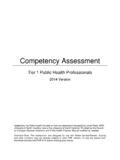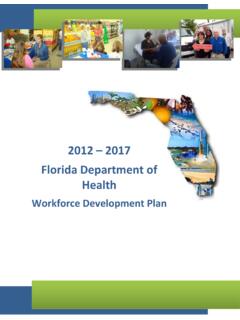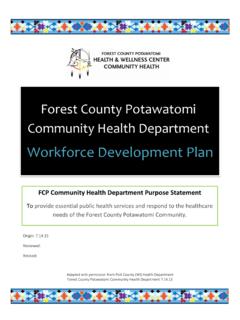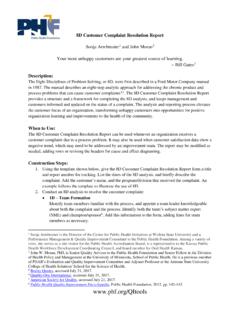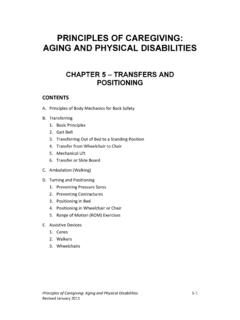Transcription of Performance Management Self-Assessment Tool - PHF
1 More Improvement Resources turning Point Performance Management National Excellence Collaborative, 2004. Performance Management Self-Assessment Tool How well does your public health organization or partnership manage Performance within its jurisdiction? Take this test to find out if you have the necessary systems in place to achieve results and continually improve Performance . Using This Tool This Self-Assessment tool will help you and your team identify the extent to which you have components of a Performance Management system. Developed by and for public health agencies, this tool is organized around each of the four components of Performance Management identified in the turning Point Performance Management National Excellence Collaborative's model (see right). Performance Standards Performance Measurement Reporting of Progress Quality (or Performance ) Improvement Process For each component, several questions serve as indicators of your Performance Management capacity.
2 These questions cover elements of your capacity such as having the necessary resources, skills, accountability, Source: turning Point. From Silos to Systems: and communications to be effective in each component. Using Performance Management to Improve the Public's Health, 2003. Contents Using This Tool ..1. Section I. Overall Readiness & Section II. Performance Standards ..5. Section III. Performance Measurement ..6. Section IV. Reporting of Progress ..7. Section V. Quality Improvement (QI) 1. turning Point Performance Management National Excellence Collaborative, 2004. Choose the Best Response Choose the response that is closest to your Tips: stage of development as follows: Yes (fully operational): You explicitly do Preview the entire tool and definitions before you begin. The this activity or have this capacity in place.
3 Detailed questions in Sections II - V may Somewhat: You explicitly do this or help you better understand Performance have this capacity, but have a way to go. Management and more accurately No: You do this barely or not at all. complete Section I, "Overall Readiness What occurs is not the result of any & Accountability.". explicit strategy. Be honest about what you are currently doing or not doing to In this tool, you does not refer to you as an manage Performance . If you are doing individual. Rather, you can choose to answer the very little in an area, it is better to say tool's questions for your "No" than to overstate the attention and Individual program or division resources allocated to it. For questions marked "No," decision makers can then Organization as a whole choose to invest resources, shift Public health system for your priorities, or determine that you will not jurisdiction including governmental be accountable for the activity.
4 Using health departments (state, local, information for such decision making is territorial, or tribal), other government a basic tenet of Performance agencies partnering in public health Management . functions, and private system partners Indicate the unit ( , program, (non-profit, academic, or business) organization, jurisdiction) for which you are completing this assessment Because Performance improvement is a shared at the top of the tool in the space responsibility throughout a public health system,1 provided. we encourage you to involve internal and external partners as you examine ways to better If you are unsure, leave it blank until you can find the answer. manage Performance . Take the Next Step In public health, we continually strive for better health for all Americans. In the same spirit, we can continually strive for better ways to manage Performance and learn from our efforts.
5 By answering the questions in this Self-Assessment , your team can identify together the most important areas to improve. Although this tool will help you and your team answer the questions, Are we really managing Performance ? and Do we have specific components of a Performance Management system? . it is only the first step to improved Performance . As you complete this assessment , or as a next step, your team should also discuss important questions such as: For those components we are doing, how well are we doing them? . In which quadrants do we need to invest more time and resources to manage Performance more successfully? . What steps could we try out this month (or this week!) to improve our Performance Management system? . Use the Notes section at the bottom of each page to write down your improvement ideas, your insights, or any qualifications to your answers.
6 Your individual or group responses will help you interpret the results and choose follow-up actions to the assessment . 1. See also the National Public Health Performance Standards Program, 2. turning Point Performance Management National Excellence Collaborative, 2004. Resources to Help If you're ready to start working on better ways to manage Performance , there are a number of resources from turning Point that can help, including the following: From Silos to Systems: Using Performance View online at . Management to Improve the Public's Health click Search, then type Performance Management (no quotes). Guidebook for Performance Measurement Order print copies at click Bookstore . Performance Management in Action: Tools and or call toll-free 877-252-1200. Resources (online only). For more information about the turning Point Performance Management National Excellence Collaborative, please visit our web site, 3.
7 Unit for which you are completing this assessment : turning Point Performance Management National Excellence Collaborative, 2004. _____. Section I. Overall Readiness & Accountability Stage of Development Some- Yes (Fully assessment Questions No what operational). 1. Is there a stated commitment from high-level leadership to a Performance Management system? 2. Is Performance being managed for at least some priority areas that are critical to your mission and function? 3. Is Performance actively managed in the following areas? (check all that apply). A. Health Status ( , diabetes rates). B. Public Health Capacity ( , communities served by a health department or program). C. Human Resource Development ( , workforce training in core competencies). D. Data and Information Systems ( , injury report lag time, participation in intranet report system).
8 E. Customer Focus and Satisfaction ( , use of customer/stakeholder feedback to make program decisions or system changes). F. Financial Systems ( , frequency of financial reports, reports that categorize expenses by strategic priorities). G. Management Practices ( , communication of vision to employees, projects completed on time). H. Service Delivery ( , clinic no-show rates). I. Other 4. Is a team responsible for integrating Performance Management efforts across the areas listed in 3A - I? 5. Are managers trained to manage Performance ? 6. Are managers held accountable for developing, maintaining, and improving the Performance Management system? 7. Are there incentives for Performance improvement? 8. Is there a process or mechanism to align the various components of the Performance Management system ( , Performance standards, measures, reports, and improvement processes focus on the same things)?
9 9. Is there a process or mechanism to align your Performance Management system with your strategic plan? 10. Is there a process or mechanism to align your Performance priorities with your budget? 11. Do leaders nurture an organizational culture focused on Performance improvement? 12. Are personnel and financial resources assigned to Performance Management functions? Notes: 4. Unit for which you are completing this assessment : turning Point Performance Management National Excellence Collaborative, 2004. _____. Section II. Performance Standards Stage of Development Some- Yes (Fully assessment Questions No what operational). 1. Do you use Performance standards that are relevant to your activities? 2. Do you set specific Performance targets to be achieved in a certain time period? 3. Are managers and employees held accountable for meeting standards and targets?
10 4. Have you defined processes and methods for choosing Performance standards, indicators, or targets?2. A. Do you use existing Performance standards, indicators, and targets when possible ( , National Public Health Performance Standards, Leading Health Indicators, Healthy People 2010)? B. Do you benchmark (compare yourself) against similar organizations? C. Do you use scientific guidelines? D. Do you set priorities? E. Do your standards cover a mix of capacities, processes, and outcomes?3. 5. Are your Performance standards, indicators, and targets communicated throughout the organization and its stakeholders or partners? A. Have individual Performance expectations been communicated? B. Do you relate Performance standards to recognized public health goals and frameworks, ( , Essential Public Health Services)? 6. Do you test your standards and targets so you are sure people understand them?




